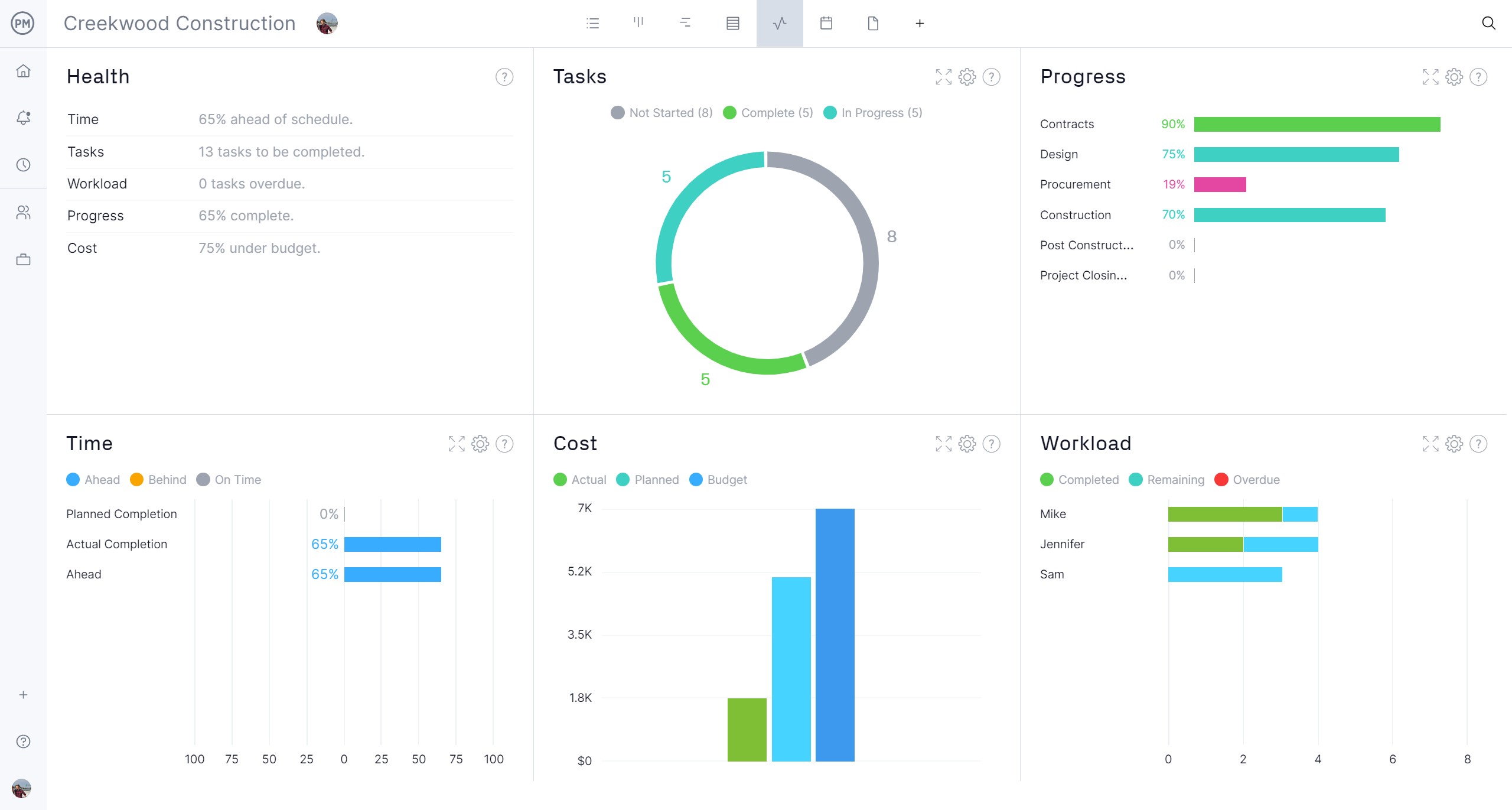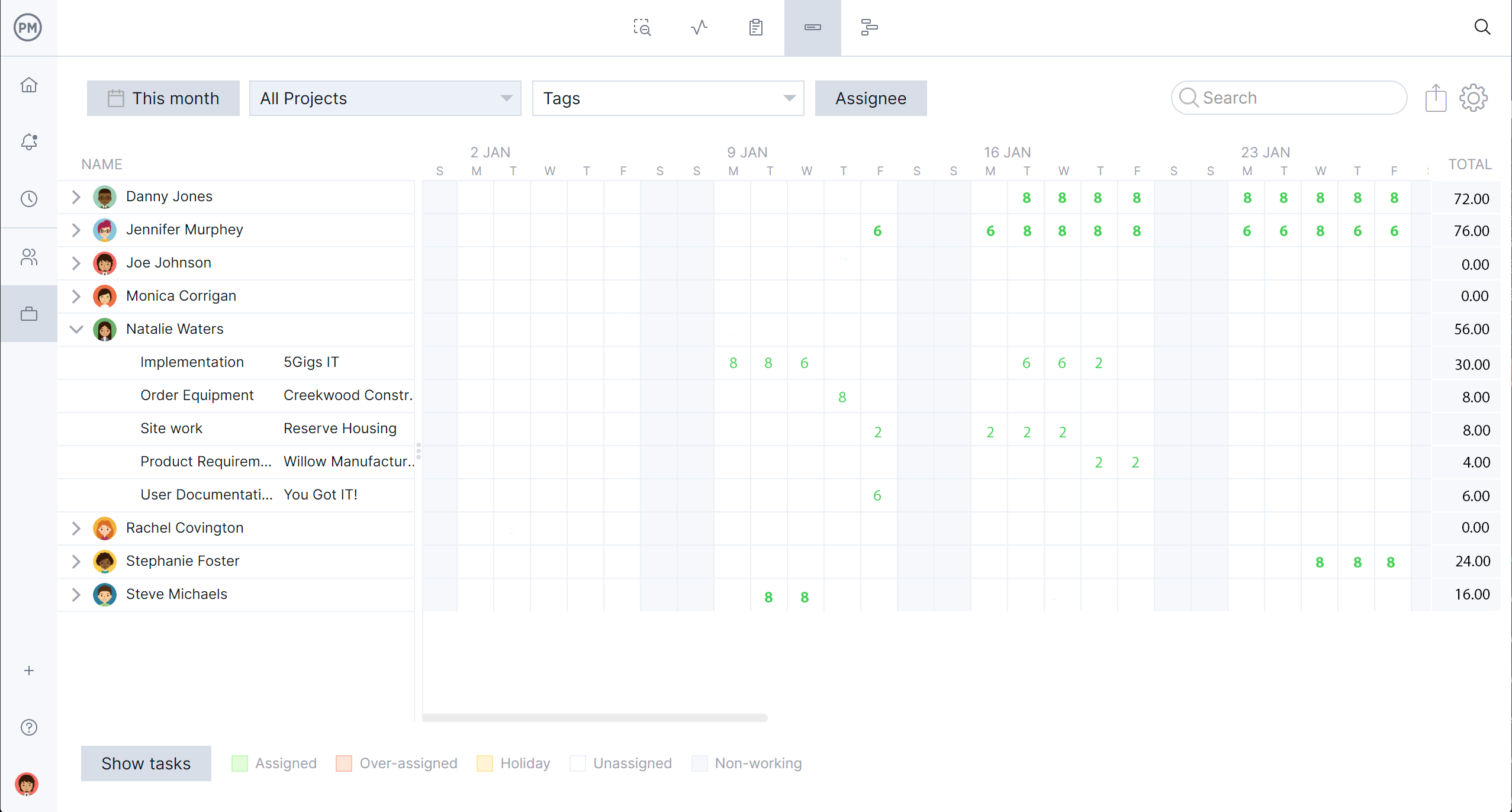Every project is different. While they all have a timeframe and end with a deliverable, they require unique methodologies and steps to reach their goals. Project strategy is the plan that defines a project, which is why project management strategy is so important.
To better manage projects, one must clearly understand project strategy, who’s responsible for it in the organization and the steps to create a project strategy. We’ll go over that and link to free project management templates that can help you in this process.
What Is Project Strategy?
Project strategy is made up of your plan and the tools that are used to complete the project. This should align with the larger goals and objectives of the organization. The project strategy works to meet the organization’s mission, but its goals are specific to the individual project it’s directing.
Once you have a basic project strategy, it can be reused for multiple projects by tweaking it to fit the new goals. That’s because whatever that future project might be it will still have to align with the organization’s long-term goals and the project strategy has already done this. However, organizations use project strategy for more complicated strategic projects rather than operational projects.
The importance of a project strategy is simple: it helps deliver projects on time, within budget and aligned with larger strategic goals. It also streamlines project planning, which increases efficiency as you work on new projects and don’t have to start at square one. Project strategy is also useful in sharing the details of a project plan with stakeholders.
To effectively plan and manage your project strategy, you’ll need a Gantt chart. ProjectManager is award-winning project and portfolio management software with robust Gantt charts that give managers transparency into how the project progresses in real time and the resources it needs to achieve its goals.
Beyond organizing tasks and adding milestones, resources and costs, users can link all four types of task dependencies to avoid costly delays. Use the filter to easily identify the critical path and set a baseline to track planned versus actual progress and costs. Get started with ProjectManager today for free.
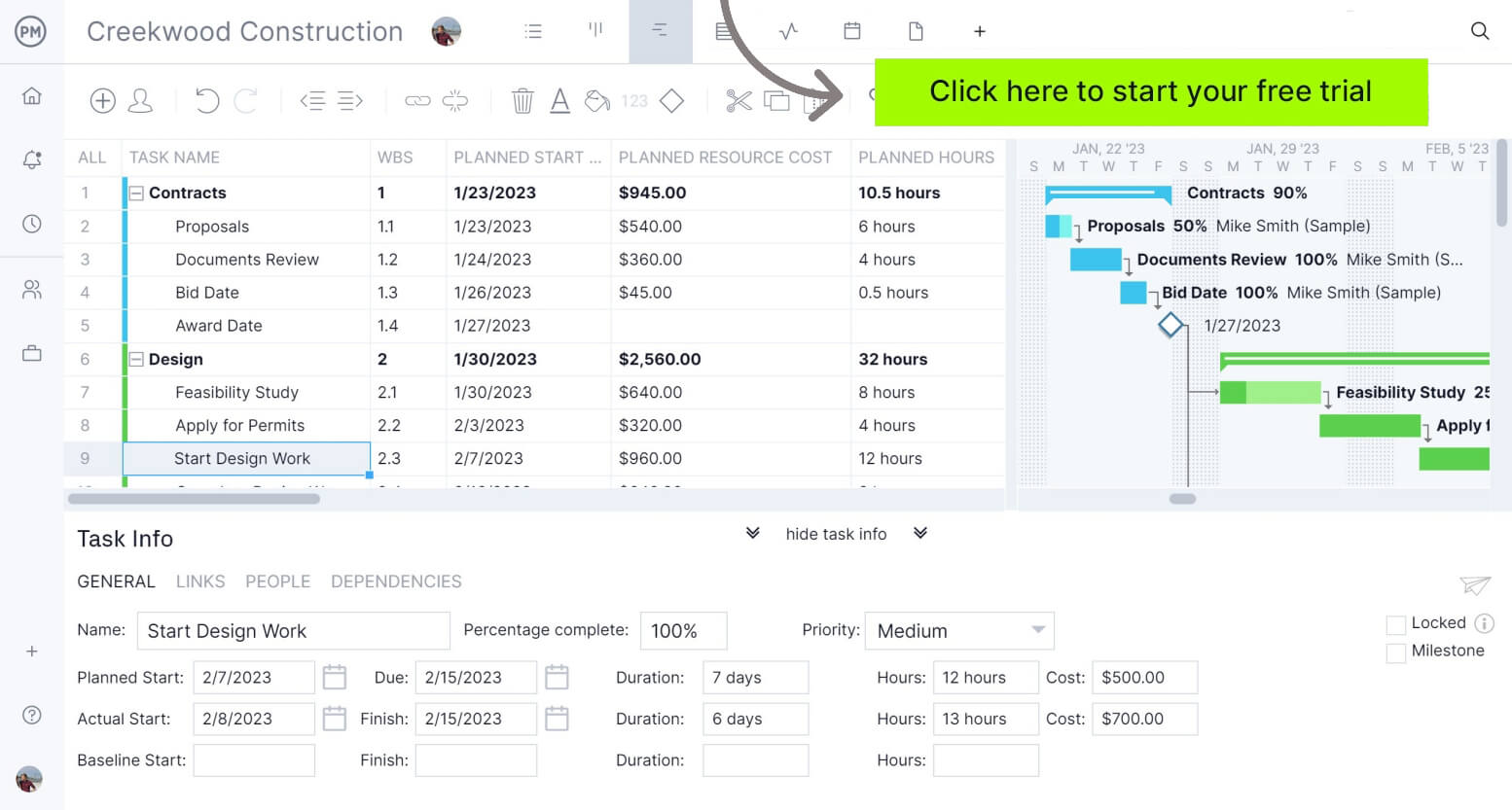
Strategic Projects vs. Operational Projects
As noted, a strategic project isn’t the same as an operational project. Strategic projects can be anything that helps deliver the organization’s strategic goals. For example, creating a website or mobile app to sell products online, marketing to promote new stores or building a facility to increase production.
Organizations need operational projects, on the other hand, for daily functions. These operational projects aren’t necessarily aligned with the organization’s strategic planning goals but are needed to keep the organization running. Some examples of operational projects are routine maintenance, training programs and upgrades to the IT infrastructure.
Who’s Responsible for Creating the Organization’s Project Strategy?
The creation process for an organization’s project strategy is in the hands of leadership and management. These are people who have interest or input on the organization’s future direction. Whoever is in charge of the organization will be involved in the project strategy, such as an owner, CEO or managing director. The following professionals will handle the actual creation of the project strategy.
- Project Management Office (PMO): A PMO is responsible for defining and maintaining the standards for an organization’s project management. They can be an internal department or an external group or an agency. They help with prioritizing projects, providing governance guidelines and ensure that projects are beneficial to the organization by aligning with larger strategic goals.
- Project Manager: This is a professional responsible for leading the project, making its schedule and budget as well as leading and managing the project team. The project manager is responsible for delivering the project on time and within budget while meeting quality standards. They’ll help align the project with the organization’s strategic goals.
- Program Manager: If the project strategy involves multiple related projects, they’re called a program and managed by a program manager. This is a more strategic position than a project manager as they’re responsible for overseeing the delivery or project strategy across multiple projects without directly managing each project.
- Portfolio Manager: If multiple projects aren’t related as in a program, it’s a portfolio. A portfolio manager is responsible for delivering them. Just as with a program manager, they oversee multiple projects to ensure that they’re all delivered successfully while also meeting the project strategy of the organization.
How to Create a Project Strategy
An organization must conceive a project strategy before identifying projects that will help achieve its long-term goals. Leadership and stakeholders should follow the steps listed below as it’s the process by which a viable project strategy can be made.
1. Define the Purpose of Your Project
The first step is knowing the underlying reason for the project you plan on initiating. One must know the why of the project: why are we doing this? The more precise and compelling your definition of the project’s purpose, the more likely it will be planned and delivered successfully.
2. Make Sure The Project Aligns With the Organization’s Strategic Plan
Once you have the purpose of the project clearly defined, look at your organization’s strategic plan. If the project’s goals are aligned with the organization’s long-term goals, then the project can move forward. If not, then you’ll need to reexamine the project. If it can’t be made to fit into the larger strategy of the organization, then you’ll have to pass.
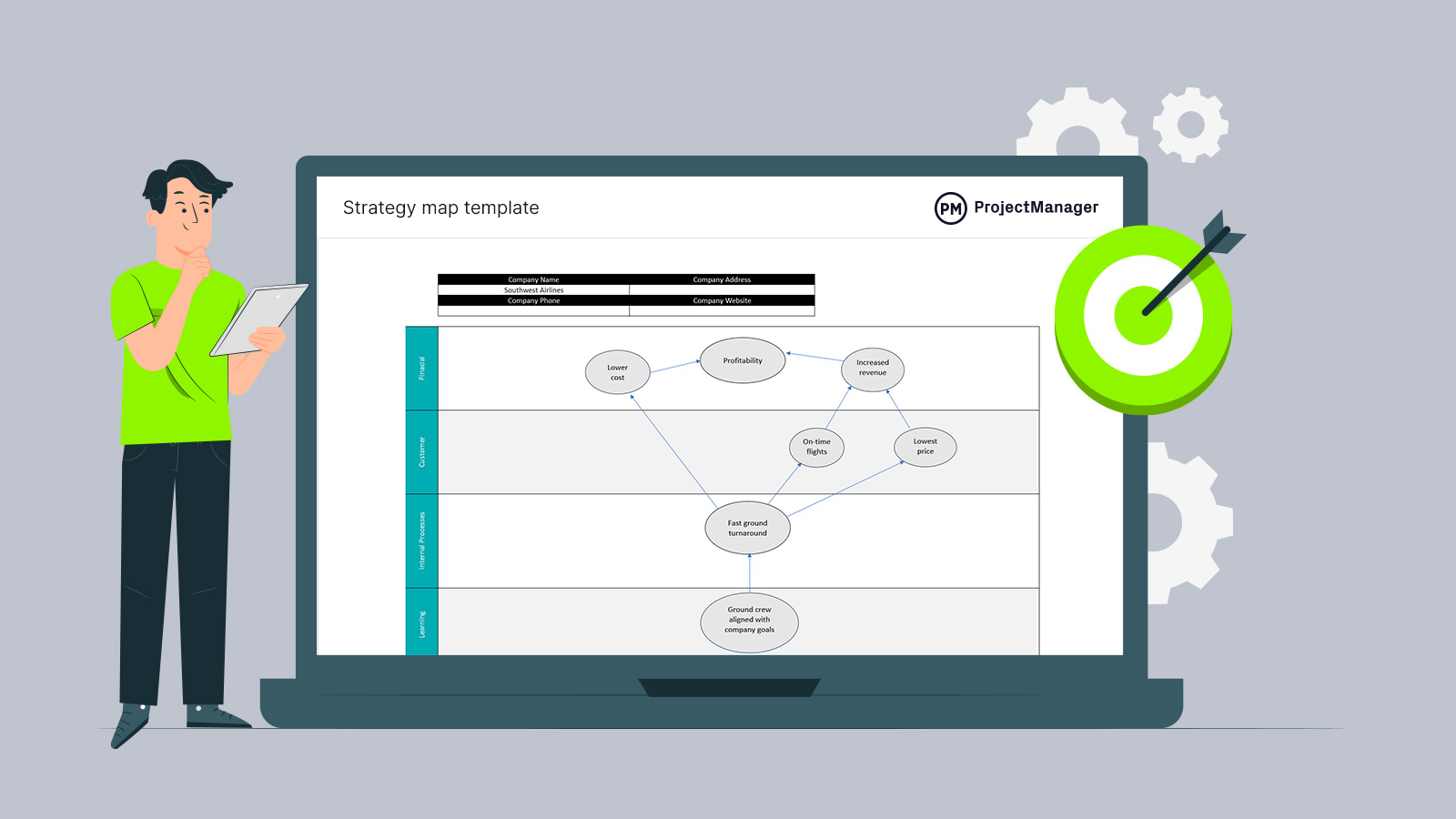
Get your free
Strategy Map Template
Use this free Strategy Map Template for Excel to manage your projects better.
3. Set Project Goals & Success Criteria
If the goals align with the project strategy of the organization, then you can move forward. The next step is to clearly define those goals. You’ll want to make sure that they’re SMART goals, which means they should be specific, measurable, attainable, relevant and time-based. At the same time, determine the success criteria for the project such as scope, budget, timeline, goals, deliverables, etc.
4. Define Your Project Scope
Identify all the work that must be completed to deliver a successful project. That’s the project scope. When defining project scope you should also identify what’s out of scope so everyone is clear on what needs to be done and what’s not necessary to the project. This sets boundaries on the project and defines its goals, deadlines and deliverables to help hit your goals.
5. Estimate Resources
Resources are the people, equipment and materials you need to complete the project. To ensure you have what you need when you need it and those costs align with your budget, estimate the resources necessary to complete the project. This will inform your schedule and budget.
6. Create a Project Budget
The project budget will determine the resources, which is the estimated costs of the project. By creating a budget, the project manager can forecast the project costs. This includes resources and how long you’ll need them.
7. Make a Project Timeline
The project timeline is a visual representation of the schedule, showing the start and end dates of the entire project and mapping the various tasks on that timeline. It also breaks the larger project down into phases, milestones and tasks, which makes it easier to manage.
8. Choose a Project Management Methodology
There are many ways to manage projects. You can use a traditional project management methodology, such as waterfall, which clearly defines the sequence of project phases, where one starts after the one before has ended. There are also agile practices, which are more iterative and collaborative with cross-functional teams. That’s only two of many sets of tools and guidelines that organize projects for greater efficiency and performance.
9. Assemble a Team
Your team will be the ones who execute the project. Selecting those team members with the right skills and experience is important, but it also helps flesh out the project’s organizational structure. The strategic goals should also be at the forefront of the project manager’s mind; the team should be chosen because they fit the bill for what’s needed to deliver the project and achieve its goals.
10. Establish Project Tracking Methods
Once the project is in motion and tasks are being worked on, the project manager needs a method to monitor and track the team’s progress and performance. The project manager will look at the project plan and compare it to the actual progress and costs to see if they’re the same. If not, then the project could be off track and adjustments to the scope, time or cost can get it back on track.
Strategic Map Template
This free strategic map template for Excel allows you to visualize the overall strategy of any organization by mapping all its strategic objectives in a chart that shows how they’re interrelated. Strategic maps are typically used to make sure all the different strategic objectives across the various departments of a business work cohesively for the accomplishment of its strategic plan.
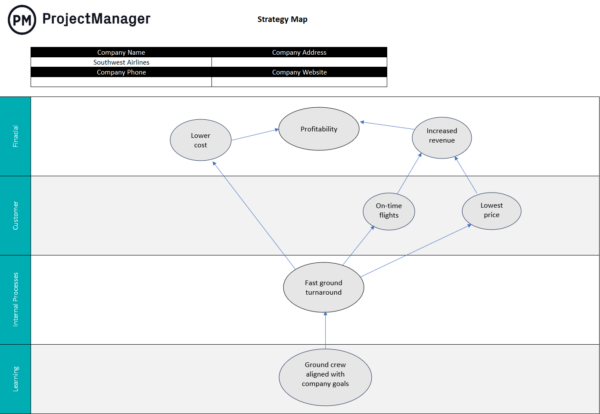
Project Management Templates That Help You Make a Project Strategy
ProjectManager isn’t only a powerful tool, but our site is an online hub for free project management templates that can help you with each phase of your project. Our free templates for Excel and Word also address various industries that run projects, such as construction, manufacturing, professional services, event planning and IT. Here are a few free templates that are related to project strategy.
Project Plan Template
A project strategy needs a project plan. Our free project plan template for Word helps you figure out everything you need from the project scope to the schedule and the budget.
Project Budget Template
To forecast an accurate budget, use our free project budget template for Excel. It lays out tasks and subtasks and their associated labor, materials and miscellaneous costs and even has columns to track the actual costs versus the budget.
Project Timeline Template
Our free project timeline template for Excel is made up of two parts. On the left is a spreadsheet for tasks and their duration. On the right is a visual timeline that populates as you fill in the left side of the template.
How ProjectManager Helps You Build Your Project Strategy
Templates are fine, but they fall short of project management software. Templates are static documents that need to be manually updated, which isn’t efficient. They’re not even good for collaboration. ProjectManager is award-winning project and portfolio management software that helps you build and execute your project strategy. Managers plan on robust Gantt charts or our sheet view, while teams can work on multiple project views, such as the visual workflow of a kanban board or task lists. You can keep stakeholders updated with the calendar view.
Track Project Costs, Time and Progress
A project strategy can’t be achieved without closely monitoring your projects. You can get a high-level overview of a project’s progress and performance anytime you want by toggling over to our real-time dashboard. Here, you’ll see KPIs such as project cost, time and progress displayed in easy-to-read graphs and charts.
There’s even a portfolio dashboard for tracking multiple projects. For more detail, use our customizable reports, such as status, portfolio, timesheet, workload, variance and more. All can be filtered to show only what you want to see and then shared with stakeholders to keep them updated.

Allocate Resources Across Projects
When you onboard teams, our software lets you set their availability, including PTO, vacation and global holidays for remote workers. This makes it easy to assign resources to tasks. As you allocate resources, use our color-coded workload chart. There, you can see at a glance who’s overallocated and balance the team’s workload from the chart. This keeps the team working at capacity and productively achieving project strategy goals.

Related Strategic Content
There’s more to project strategy and strategic planning than we could write about here. If you’re interested in going deeper, our site is full of free content, videos and templates to explore. Here are a handful of links that will take you to more articles, templates and guides on business strategy.
- Strategic Project Management: Planning Strategic Projects
- How to Create a Strategic Roadmap for Your Organization
- Strategic Planning in Business
- Strategic Plan Template for Word (Free Download)
- A Quick Guide to Strategic Initiatives
ProjectManager is online project and portfolio management software that connects teams in the office, out in the field and anywhere else they’re working. They can share files, comment at the task level and stay updated with email and in-app notifications. Join teams at Avis, Nestle and Siemens who are using our software to deliver successful projects. Get started with ProjectManager today for free.

